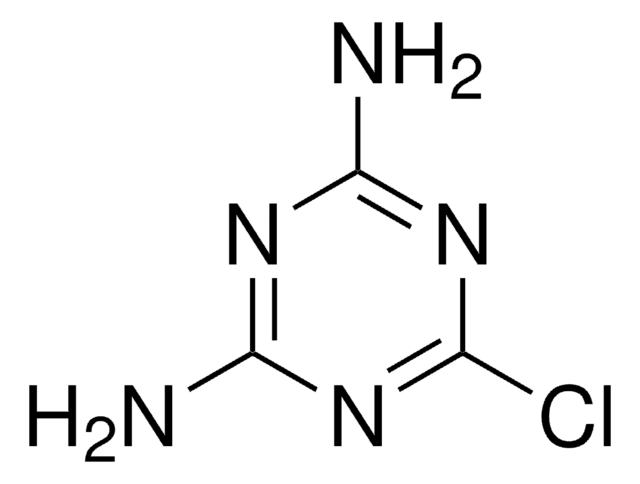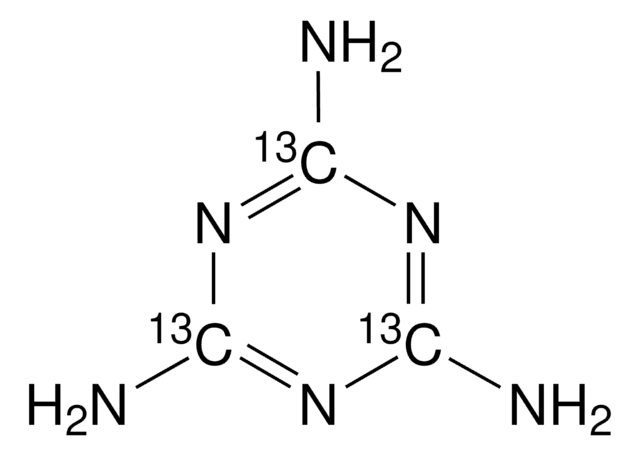When a substance is described as "soluble 17.4%" in DMSO, it means that 17.4 grams of the solute can dissolve in 100 milliliters of DMSO. Therefore, in 1 liter (1000 milliliters) of DMSO, approximately 174 grams of the solute can be dissolved.
185809
Cyanuric acid
98%
Sinónimos:
1,3,5-Triazine-2,4,6-triol, 2,4,6-Trihydroxy-1,3,5-triazine
Seleccione un Tamaño
39,80 €
Seleccione un Tamaño
About This Item
39,80 €
Productos recomendados
Ensayo
98%
mp
>360 °C (lit.)
solubilidad
water: soluble 0.2% at 25 °C(lit.)
water: soluble 10% at 150 °C(lit.)
DMSO: soluble 17.4%(lit.)
water: soluble 2.6% at 90 °C(lit.)
DMF: soluble 7.2%(lit.)
acetone: insoluble
alcohol: soluble (hot)(lit.)
benzene: insoluble
chloroform: insoluble
diethyl ether: insoluble
hydrochloric acid: soluble (conc.)
methanol: insoluble (cold)
potassium hydroxide solution: soluble
cadena SMILES
O=C1NC(=O)NC(=O)N1
InChI
1S/C3H3N3O3/c7-1-4-2(8)6-3(9)5-1/h(H3,4,5,6,7,8,9)
Clave InChI
ZFSLODLOARCGLH-UHFFFAOYSA-N
¿Está buscando productos similares? Visita Guía de comparación de productos
Categorías relacionadas
Descripción general
Aplicación
- iTRAQ-based proteomics analysis reveals the deregulated proteins related to liver toxicity induced by melamine with or without cyanuric acid in mice.: This study used iTRAQ-based proteomics to analyze liver toxicity in mice induced by melamine and cyanuric acid, identifying deregulated proteins associated with liver damage (Yin et al., 2019).
- The contribution of mediated oxidation mechanisms in the electrolytic degradation of cyanuric acid using diamond anodes.: The research investigates the electrolytic degradation of cyanuric acid using diamond anodes, focusing on mediated oxidation mechanisms for effective degradation (Bensalah et al., 2016).
- Encapsulation of [(SO₄)₄(H₂O)₁₁₂]⁸⁻ clusters in a metal organic framework of pyridyl functionalized cyanuric acid based tris-urea.: This paper explores the encapsulation of sulfate clusters in a metal-organic framework using pyridyl-functionalized cyanuric acid, highlighting its potential in material science applications (Dutta et al., 2015).
- Comparing atrazine and cyanuric acid electro-oxidation on mixed oxide and boron-doped diamond electrodes.: This study compares the electro-oxidation of atrazine and cyanuric acid on different electrodes, providing insights into the efficiency and mechanisms of electrochemical degradation processes (Malpass et al., 2013).
- Anion-pi interactions in cyanuric acids: a combined crystallographic and computational study.: The research examines anion-pi interactions in cyanuric acids through crystallographic and computational methods, contributing to the understanding of supramolecular chemistry (Frontera et al., 2005).
Código de clase de almacenamiento
11 - Combustible Solids
Clase de riesgo para el agua (WGK)
WGK 1
Punto de inflamabilidad (°F)
Not applicable
Punto de inflamabilidad (°C)
Not applicable
Equipo de protección personal
dust mask type N95 (US), Eyeshields, Gloves
Elija entre una de las versiones más recientes:
¿Ya tiene este producto?
Encuentre la documentación para los productos que ha comprado recientemente en la Biblioteca de documentos.
Los clientes también vieron
-
DMSO: soluble 17.4%(lit.) Does it means 174 g in 1 liter?
1 respuesta-
¿Le ha resultado útil?
-
-
How is shipping temperature determined? And how is it related to the product storage temperature?
1 respuesta-
Products may be shipped at a different temperature than the recommended long-term storage temperature. If the product quality is sensitive to short-term exposure to conditions other than the recommended long-term storage, it will be shipped on wet or dry-ice. If the product quality is NOT affected by short-term exposure to conditions other than the recommended long-term storage, it will be shipped at ambient temperature. As shipping routes are configured for minimum transit times, shipping at ambient temperature helps control shipping costs for our customers. For more information, please refer to the Storage and Transport Conditions document: https://www.sigmaaldrich.com/deepweb/assets/sigmaaldrich/marketing/global/documents/316/622/storage-transport-conditions-mk.pdf
¿Le ha resultado útil?
-
-
How can I determine the shelf life / expiration / retest date of this product?
1 respuesta-
If this product has an expiration or retest date, it will be shown on the Certificate of Analysis (COA, CofA). If there is no retest or expiration date listed on the product's COA, we do not have suitable stability data to determine a shelf life. For these products, the only date on the COA will be the release date; a retest, expiration, or use-by-date will not be displayed.
For all products, we recommend handling per defined conditions as printed in our product literature and website product descriptions. We recommend that products should be routinely inspected by customers to ensure they perform as expected.
For products without retest or expiration dates, our standard warranty of 1 year from the date of shipment is applicable.
For more information, please refer to the Product Dating Information document: https://www.sigmaaldrich.com/deepweb/assets/sigmaaldrich/marketing/global/documents/449/386/product-dating-information-mk.pdf¿Le ha resultado útil?
-
-
what is the particle size ?
1 respuesta-
The particle size for this product is not determined.
¿Le ha resultado útil?
-
Filtros activos
Nuestro equipo de científicos tiene experiencia en todas las áreas de investigación: Ciencias de la vida, Ciencia de los materiales, Síntesis química, Cromatografía, Analítica y muchas otras.
Póngase en contacto con el Servicio técnico










